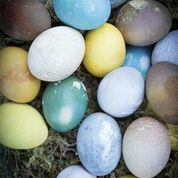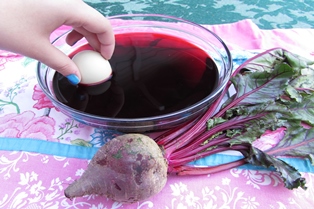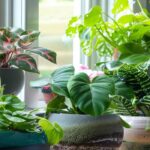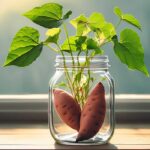Dye Your Easter Eggs Naturally...And Much More


If you’ve thought about dyeing your Easter eggs naturally with items like beets or have tried with limited success, there’s a new book that will inspire you to make your own dyes for eggs and much more. Open up A Garden to Dye For : How to Use Plants from the Garden to Create Natural Colors for Fabrics & Fibers (St. Lynn’s Press) and enter the world of using kitchen scraps and plants from your garden to create beautiful, natural dyes.
Budding botanical alchemist Chris McLaughlin is author of the book, and she artfully guides you through the process of growing, harvesting and using plant materials to create stunning dyes for a wide variety of items, including clothing like scarves. The author started experimenting with plant dyes 20 years ago after reading an article on dyeing eggs naturally using plants.
“For a long time, I played around with this subject, as well as pounding flowers for color,” says the garden blogger, whose site is Home AG, a Suburban Farmer. “When I became interested in hand spinning, I was reintroduced to botanical dyes as it applies to dyeing fiber. I was transfixed and never looked back.”
During her journey discovering natural dyes, McLaughlin didn’t run across any other gardeners dabbling in pulling color from the garden, so she decided to write the book.
“I thought surely it was the plant lover who should be playing around with botanical colors, but these dyeing techniques seemed to remain in the fiber artist circles,” she says. “I decided to bridge the gap between mainstream gardeners and the hand crafter world. I wrote the book from the perspective of a plant, animal and fiber lover, experimenter and student of the arts.”
Pick up a copy of McLaughlin’s book to learn how to make your own dyes with step-by-step recipes. The book includes a section on more than 40 plants you may have in your garden or home right now and the rainbow of colors they have to offer.
Since Easter is upon us, the author shares how to dye gorgeous Easter eggs naturally.
Dye Your Own Easter Eggs
Easter eggs are usually naturally dyed in a hot bath, which means that the eggs are colored at the same time they’re being hard-boiled; or they can be dyed in a cold bath. McLaughlin prefers the cold method, because the colors come out much more intense and you can make a variety of dyes in advance. The cold dye recipe is shared here. (You can read about the hot method in the book.)
What you’ll need to cold dye your own Easter Eggs:
- Non-reactive dyepots
- Water
- Glass jars or bowls (for cold method)
- Eggs
- White vinegar
- Dyestuff: onion skins, blueberries, blackberries, red cabbage, coffee, chamomile, turmeric, beets, coreopsis, rudbeckia, marigolds, calendula
Cold Egg Dye Method
Make the dyes by simmering the respective plant materials in pots of water for 20 – 25 minutes. Strain off the dyestuff, add 1/8 cup of vinegar and let the liquid cool in jars. Once the dye is cool, add an already hard-boiled egg to each dye color and leave them there for at least an hour – but for the most impressive colors, leave them in there up to 10 hours.
If you leave the hard-boiled egg in the dye for longer than two hours, refrigerate it during the dyeing process for health safety reasons. And never use any plant materials that are considered poisonous for eggs. Use only what you know to be safe, edible foods and plants.
McLaughlin also suggests taking good notes and keeping samples of your favorite dye colors. “If you’re an experimenter, you will NOT remember how you arrived at that beautiful color,” she says.
Once you’ve gotten the hang of dyeing Easter eggs, you’ll soon find yourself looking around your garden and saying to yourself, I can dye that.






 How To Grow Sweet Potato Vine Indoors
How To Grow Sweet Potato Vine Indoors